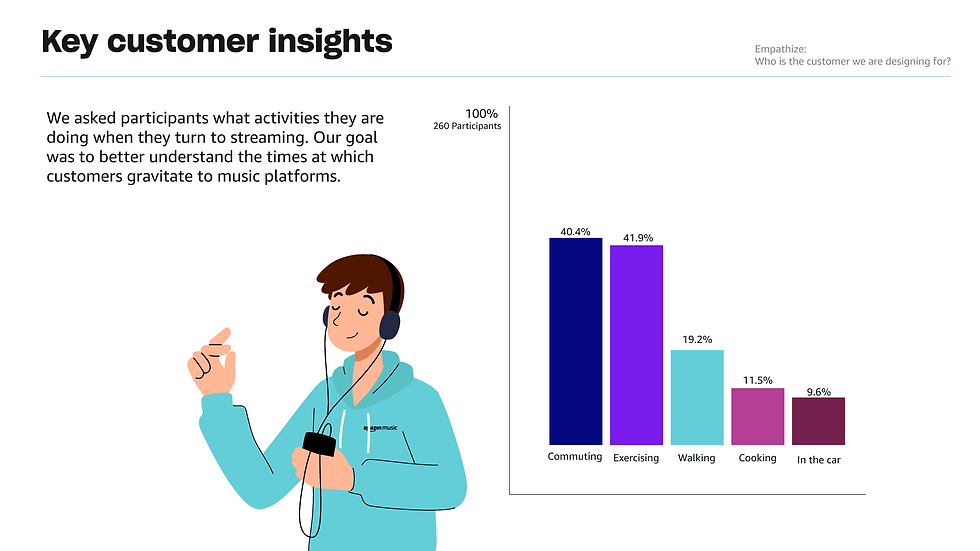Amazon Music
Reimagining the future of the music streaming platform through Snippets & Credits
DESIGN HACKATHON

BRIEF
The Design Challenge
Amazon Music in collaboration with Pratt Institute organized a school wide design challenge. The brief was:
“What is the future of the listener’s experience with music and podcasts? Look 3-5 years out to develop a concept that leverages the Amazon Music service offerings and reach to bridge digital, in real life, communal, and individual experiences via the use of new devices and emerging technology.”
Over 21 different teams had worked for the four weeks to come up with different solutions. Out of this three teams were shortlisted to present to Amazon Music in front of the various product designers, the VP of Design and the event was live streamed to an audience of 4000 people in the offices. Our team emerged as the winner of the challenge.
DURATION
4 weeks
TEAM MEMBERS
Stacey O'Carol, Katie Im, John Kellejan
ROLE
UX researcher, Product Designer
TOOLS
Figma, Miro, Google Forms
Project overview
Streaming has changed how people listen to music and constitutes 62.1% of the total music industry’s revenue. Gen-Z is an emerging audience that prioritizes short-form content discovery and fairly compensates the artists they support. From our direct customer insights, we envisioned the future of Amazon music as a space where listeners can discover exciting emerging artists through Snippets and support them in their music journey directly by giving Credits.
Snippets is a short-form medium exclusively for music discovery, making it easier for artists to reach their target listeners. Emotion, Location, or Activity filters help guide the types of Snippets they aim to hear. The algorithm will show Snippets based on the filters and the user’s taste.
Credits are a way for all listeners to empower their favorite artists directly. Users can share some of the monthly credits they gain from any subscription plan which translates into direct revenue for the artist.


PROCESS
From planning to presenting
We followed the Nielson Norman steps of design thinking in the project. This ensured that we had devoted enough time to discovering who our user was, understanding their pain points and designing to fulfill their future expectations from the platform.

1. EMPATHIZE
Who is our customer?
User Survey
In order to answer this question we conducted user surveys and interviews. We created a structured close ended questionnaire on google forms and circulated that in our network. We got over 260 responses from an international audience from 12 countries.




Once we got the big picture overview we wanted to delve deeper and gain some qualitative insights. We conducted 16 semi structured user interviews to understand the music preferences
User Interviews

Through our research we distilled our findings into three major themes. The need for representing artists fairly, short form content discovery and improving social experiences.
Key Insights

2. DEFINE
What is our customer's problem?
Based on our interviews and surveys we created a user persona and synthesized a HMW statement to help guide our next stages and be more focused.

OUR PROBLEM STATEMENT
How might we improve Amazon music so that young music listeners can discover new music and see a fair representation of artists.
3. IDEATE
How did we come up with ideas?
Based on the insights from our research we conducted feature design sprints where we devoted 30 mins to sketching and then discussed and voted on ideas.

4. PROTOTYPE
How did our designs solve the user's problem?
Before getting into the wireframes we spent some time mapping out the proposed user journey with the touchpoints. We also identified how our features would fit into the services ecosystem.

Reimagined user journey

Feature fit in the current ecosystem

We started prototyping by creating medium fidelity wireframes which allowed us to flesh out our features, create user flows and iterate on them rapidly. After that, we created high fidelity UI designs by leveraging the current design system and making our screens visually impactful and functionally sound.

TEST
How did we validate our design decisions?
We conducted a quick usability test on 5 participants in the age group of 22-30 and asked them about their overall impressions along with their experience of using our key features like credits and snippets




IMPLEMENT
What were our proposed features?
1. Snippets
Since we were targeting a Gen Z population, we proposed a short content discovery feature which would
allow our users to find new artists and also personalize based on emotions, location or activity.


2. Credits
Through our research we found a need for music equity and being able to support their favorite artists. Through credits the users will have the ability to devote a portion of their monthly credit which financially supports the emerging artists and allows them to create.

Learnings & Next steps
This challenge was a great learning experience. We started from the brief and were able to pitch to Amazon’s leadership in a span of 4 weeks. The teamwork was quite instrumental to us winning the challenge. There was mutual respect and along with playing to our strengths we were also ready to broaden our horizons. It also was an accelerated learning environment and we were able to go through the entire product cycle and stages of design thinking. Big thank you to everyone who helped organize this challenge!
